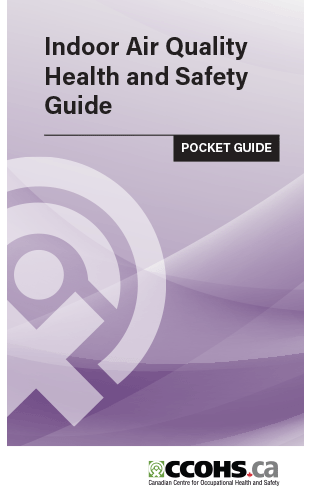Scheduled maintenance - Thursday, July 12 at 5:00 PM EDT
We expect this update to take about an hour. Access to this website will be unavailable during this time.
Identify potential indoor air quality problems and take steps to control them.


Designed and written as a practical workplace training and reference tool. This 150-page pocket guide is filled with clear-language text including safety tips, charts, diagrams, checklists and illustrations.
This guide will help you to:
In this Guide, Indoor Air Quality refers to the total indoor environment, which encompasses air contaminants, lighting, noise, temperature, humidity and workstation design.A healthy indoor environment includes the following:
In the past, symptoms reported by building occupants were often considered psychological because the symptoms seemed variable and subjective, and because an exact cause could not be identified.
Today, IAQ problems can be identified through workplace inspections and an analysis of worker health complaints. It is possible to control many health symptoms through effective building maintenance programs and by controlling specific air contaminants and their sources.
This Guide outlines how to identify potential IAQ problems and how to take steps towards controlling these problems. Actual recognition and control of IAQ problems may require specialists and a team approach involving complex measurement, analysis and implementation of controls.
This guide is intended for non-industrial indoor workplaces which include offices, meeting facilities, schools, health care facilities and stores. It is an ideal work companion for managers, building management, maintenance staff, occupational health nurses, industrial hygienists, building designers, interior designers, engineers and health care professionals.
Each publication produced by CCOHS undergoes several stages of review. As part of this review, representatives from government, employers, and labour are requested to comment on draft copies of CCOHS documents for technical accuracy and readability.
Although every effort is made to ensure accuracy and completeness of the information, it is understood that CCOHS makes no warranty as to the accuracy or completeness of such information and assumes no liability for any damages or loss suffered as a result of any inaccuracy or incompleteness therein.
CCOHS publications are unique in that they are developed by subject specialists in the field, and reviewed by representatives from labour, employers and government to ensure the content and approach are unbiased and credible.
Although our publications are protected by copyright, permission for non-commercial reproduction may be provided.
Please use our Copyright Authorization Form to request permission, or contact us for more information.